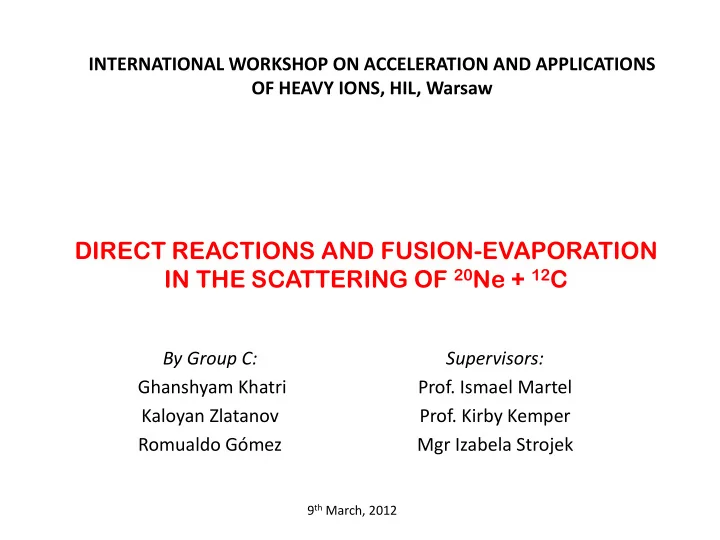

INTERNATIONAL WORKSHOP ON ACCELERATION AND APPLICATIONS OF HEAVY IONS, HIL, Warsaw DIRECT REACTIONS AND FUSION-EVAPORATION IN THE SCATTERING OF 20 Ne + 12 C By Group C: Supervisors: Ghanshyam Khatri Prof. Ismael Martel Kaloyan Zlatanov Prof. Kirby Kemper Romualdo Gómez Mgr Izabela Strojek 9 th March, 2012
Motiv ivation tion TYPICAL MASS IDENTIFICATION Detailed study of nuclear reactions at energies around the barrier: SPECTRUM -Better understanding of the competition between direct reactions D. Shapira, et al. PRC26 (1982)2470 and fusion-evaporation processes -Test our knowledge of nuclear potentials and reaction models with stable beams, improve our theoretical tools needed to investigate exotic nuclei - FRESCO: Direct reactions - PACE4: Fusion-evaporation Interesting system itself: the 12C+ 20Ne and16O+16O systems should lead to same final compound nucleus 32S: Are direct reactions and fusion evaporation comparable in both systems? Previous investigations: R. Vandenbosch, et al, PRL 33, 842 (1974). R. G. Vandenbosch and K. G. Bernhardt, J. Phys. Lett. 37, L161 (1976). H. Doubre, et al., PRC 17, 131(1978). J. Menet, et al, J. Phys. 38, 1051 (1977), F. Osterfeld, et al,Phys. Lett. 68B, 319 (1977). F. Saint Laurent, et al, NPA327, 517 (1979). ADVANTAGE OF MODERN DETECTOR SETUPS (ICARE) AND HIGH INTENSITY BEAMS PRODUCED AT HEAVY ION LAB AT WARSAW (POLAND)
Beam energy: ~ 55 MeV (~ 20 MeV CM ) rapidly available at HIL Cyclotron with highest intensity (~ 1 nA) -Just above the Coulomb barrier for 12 C+ 20 Ne system (13 MeV CM ) - Inverse kinematics: forward focussing of relevant fragments good setup for a 6 hours measurement Preliminary calculations to determine relevant cross sections: angular range and resolution, Kinematics of fragments, Expected statistics Elastic cross sections simple OM (http://nrv.jinr.ru/nrv/webnrv/elastic_scattering) with global parameters of R.O. Akyuz and A. Winther (Proc. Enrico Fermi Int. School of Physics, 1979, “Nuclear structure and heavy-ion reactions ”, ed. R.A. Broglia, C.H. Dasso and R. Ricci (North-Holland, Amsterdam, 1981) p. 491 Nuclear Potential Elastic diff. Cross-section Smooth angular distribution COLLISION ENERGY ~ dθ ~ +/- 2 º OK ~ 20 MeV CM or 55 MeV LAB 80ºCM 24º LAB (mb/sr) V(MeV) COULOMB BARRIER ~13 MeV 1 mb FULL COUPLED CHANNELS CALCULATION WITH FRESCO REACTION THEORY GROUP D
Kinematics of direct reactions Catkin FUSION-EVAPORATION personal.ph.surrey.ac.uk/~phs1wc/kinematics/ Simulation with PACE4 60.00 50.00 40.00 α transfer to Elab (MeV) 16O(gs) 30.00 20.00 Elastic 20Ne 10.00 0.00 0.00 10.00 20.00 30.00 40.00 50.00 60.00 70.00 θLab 30 P Angular distribution 27 Al Angular distribution 45000 40000 35000 30000 COUNTS Max. Max. COUNTS 25000 observation observation angle 20000 angle 15000 10000 5000 0 0 5 10 15 20 θ Lab θ Lab
Experi erimental mental Setup ICARE Setup Located at Hall D , Heavy Ion Laboratory Beam of 53.6 MeV 20 Ne +3 ions at 4 pnA from Cyclotron (K=160) photo credit : I. Strojek
Schematics of the target chamber Detector t04 : @ 11 ͦ fjxed angular positjon Detector t09 and t05 : @ 15 ͦ relatjve angular pos. Targets: 12 C @60 μ g/cm 2 (thanks to Anna Stolarz !) photo credit : I. Strojek
Gas-Si telescope ( Δ E-E detector): Gas: Iso-Butane @ ~14 mbar Entrance Window: Mylar foil @ 2.5 μ m Diameter @ 10 mm Silicon @ 500 μ m photo credit : I. Strojek
Resu sults: lts: 12C target 12C target gold target @ 7 ͦ @ 11 ͦ P @ 7 ͦ Si Δ E (MeV) Al Ne Only elastic Ne O C α p E (MeV) 12C target 12C target @ 15 ͦ @ 19 ͦ Δ E-E Telescope spectra: @ gold and 12C target Δ E(MeV) @ 53.6 MeV E (MeV)
Also some gs and excited states have been identified : 2 + (4.4 MeV) Carbon Oxygen Neon elastic 2 + (6.9 MeV) 4 + (10.3 MeV) 0 + (7.8 MeV) Counts gs gs E (MeV)
Aluminum yield FUSION-EVAPORATION Simulation with PACE4 “Tail” contaminats from Z >= 15 27Al Counts E (MeV)
Silicon yield FUSION-EVAPORATION Simulation with PACE4 Strong suppression of Counts 28Si production 30Si 29Si 28Si 27Si E (MeV)
Alpha yield FUSION-EVAPORATION Simulation with PACE4 Counts E (MeV)
Elastic Diff. cross-sections: 12 C( 20 Ne, 20 Ne) 12 C (mb/sr) dot – Exp. line – Theory Comparison with results obtained by theory Group D lab (mb/sr) Fusion Evaporation and direct reaction yields (normalized to elastic channel)
Summary mary and Conclusi lusions ons: -We have measured angular distributions of direct reactions and fusion-evaporation yields for the system 20Ne+12C at 53.6 MeV, using the ICARE setup at Heavy Ion Laboratory (Warsaw): -Fusion – Evaporation: alphas, yields of 27Al, silicon isotopes and possibly phosphorus isotopes. - Direct reactions: Elastic 20Ne, alpha transfer to 16O and 12C reaction channel. - Preliminary simulations performed with Pace4 can describe the fusion-evaporation data, suggesting strong suppression of 28Si when comparing with experiment. -Direct reaction analysis based on FRESCO will be presented by the REACTION THEORY GROUP D. - Data analysis is still in progress
Acknowledgement We would like to thank to all for their support and help: • Prof. Krzysztof Rusek (director of HIL) • Dr Magda Zielinska • HIL staff, specially cyclotron operators • Prof. Stanislaw Kistryn from UJ, Krakow • Dr Agnieszka Trzcinska (PAW++ woman) • Group B and Group D at the workshop • European Commission • Foundation for Polish Science (FNP) • …
Our group Prof. Kirby W. Kemper is not present during the Photo-shoot
Thank you for your attention
Recommend
More recommend